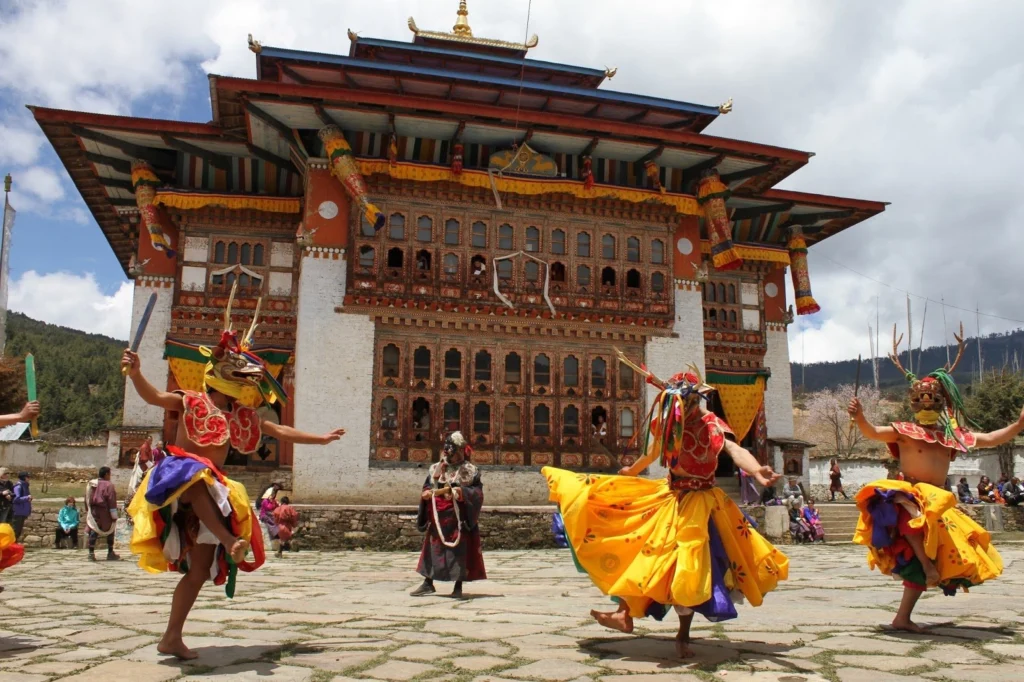Bumthang
Timeout Bhutan Travel – Your Best Travel Partner in Bhutan
Bumthang: A Journey Through Bhutan's Spiritual Heart
Revered as the spiritual heartland of the kingdom, Bumthang offers visitors a unique blend of natural beauty, rich cultural heritage, and spiritual sanctuaries.

Bumthang Valley welcomes travelers with its serene landscapes, lush meadows, and pristine rivers. Surrounded by snow-capped peaks and verdant forests, the valley exudes an aura of tranquility, inviting visitors to immerse themselves in the peaceful embrace of nature.
Bumthang is home to some of the most revered temples and monasteries in Bhutan. Explore the ancient Jambay Lhakhang, believed to have been built in the 7th century by Tibetan King Songtsen Gampo to pin down an ogress. Marvel at Kurjey Lhakhang, where Guru Rinpoche meditated and left his imprint on a rock. Visit Tamshing Lhakhang, known for its exquisite murals depicting the life of Guru Rinpoche. These sacred sites offer a glimpse into Bhutan’s rich religious heritage and provide a serene setting for spiritual contemplation.
In Bumthang, time seems to stand still as you wander through ancient temples, meander along winding trails, and immerse yourself in the timeless beauty of the valley. Whether you seek spiritual enlightenment, cultural immersion, or simply a moment of peace amidst nature, Bumthang offers a sanctuary for the soul unlike any other.

For outdoor enthusiasts, Bumthang offers a plethora of trekking and hiking opportunities amidst breathtaking scenery. Embark on the Bumthang Cultural Trek, which takes you through picturesque villages, ancient monasteries, and dense forests teeming with wildlife. Hike to the mystical Mebar Tsho (Burning Lake), where Guru Rinpoche is said to have hidden sacred treasures. Or simply stroll through the tranquil countryside, soaking in the beauty of the surroundings.



Where the whispers of ancient temples mingle with the melodies of nature.

Must-Visit Areas in Bumthang
Jakar Dzong: Also known as the “Castle of the White Bird,” Jakar Dzong is the largest and most important dzong in Bumthang. Situated on a ridge overlooking the valley, it offers panoramic views of the surrounding landscape and serves as the administrative center of the region.
Jambay Lhakhang: This ancient temple, believed to have been built in the 7th century by Tibetan King Songtsen Gampo, is one of the 108 temples built to subdue a demoness that lay across the Himalayas. It is known for its unique architectural features and sacred relics.
Kurjey Lhakhang: Located near Jakar town, Kurjey Lhakhang is one of the most sacred sites in Bhutan. It is believed to be the resting place of the body imprint of Guru Rinpoche, the founder of Tibetan Buddhism. The temple complex also includes three other temples and several sacred monuments.
Tamshing Lhakhang: Founded in the early 16th century by the renowned Buddhist master Pema Lingpa, Tamshing Lhakhang is one of the oldest temples in Bhutan. It is famous for its beautiful murals, which depict the life of Guru Rinpoche and other Buddhist deities.
Mebar Tsho (Burning Lake): This sacred site is located on the way to Tang Valley and is associated with the renowned treasure revealer, Pema Lingpa. According to legend, Pema Lingpa jumped into the lake with a burning lamp and emerged with treasures and scriptures, thus earning the name “Burning Lake.”
Ura Valley: This remote valley, located on the eastern side of Bumthang, is known for its scenic beauty and traditional way of life. Visitors can explore the picturesque villages, interact with the friendly locals, and experience the unique culture of the region.
Tang Valley: Tang Valley is famous for its apple orchards, pristine landscapes, and historic sites. Visitors can hike to the beautiful Ogyen Choling Palace, explore traditional villages, and enjoy the tranquility of the countryside.
Red Panda Brewery: For those interested in sampling local brews, a visit to the Red Panda Brewery is a must. This microbrewery produces a variety of craft beers using locally sourced ingredients, including barley grown in the Bumthang Valley.

WHAT WE DO
- Customize Authentic vacations
- Go above and beyond
- Put your best interests first
- Expect exceptional reviews
- Value relationships
- Exceed expectations
- Find those hidden gems
WHAT WE DON'T DO
- We don’t customize Cookie-cutter travel
- We don’t sacrifice quality for profit
- We don’t overpromise
- We are not inflexible
- We are not the same as everyone else
- We don’t act closed-minded
- We don’t lack imagination
Latest Blogs
FAQs for Your Bhutan Tour Adventure
The currency of Bhutan is the Ngultrum (BTN). Indian Rupees are also accepted in Bhutan, but notes of 2,000, 500, and 200 are not commonly accepted. It’s advisable to carry cash, as ATMs might not be widely available, especially in rural areas, and not all places accept credit cards.
Bhutan is considered one of the safest countries for tourists.
It’s recommended to consult with a healthcare provider for vaccinations and health advice at least 4 to 6 weeks before your trip.
Respect local traditions and dress modestly, especially when visiting religious sites. Always ask permission before taking photographs of people or religious icons. It’s also customary to remove your shoes before entering temples and some homes.
Yes, attending a Tshechu (religious festival) is a highlight of visiting Bhutan.
Due to the limited number of tourists allowed to enter Bhutan and the need to arrange visas and travel permits, it’s advisable to plan your trip at least 3 to 6 months in advance, especially if you’re planning to visit during the high season or attend a popular festival.
Travel within Bhutan is usually arranged by your tour operator, including private vehicles for transportation between cities and to tourist sites. For trekking tours, transportation of equipment is typically handled by yaks or horses, with guides leading the way.
Contact Us
Don’t hesitate to contact us for any quotes or sample itineraries. We’re here, happy and ready to serve you in every way possible.
Follow Us
- Motithang: Thimphu
- +975 17 11 38 18
- timeoutbhutan@gmail.com
